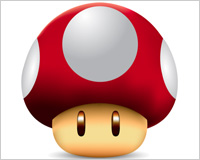 In this post, we’re going to learn about a bit about Illustrator's Mesh tool.
It’s one of the hardest tools to master in Illustrator, but if you want to achieve a 3-D look in your illustrations, you have to really understand how to use this tool properly.
We’re going to create a Super Mario-style mushroom in order to better understand how to use this tool using a real life example.
When you get to the end of the tutorial, please share your results with us. And do let us know if you ran into any trouble along the way.
In this post, we’re going to learn about a bit about Illustrator's Mesh tool.
It’s one of the hardest tools to master in Illustrator, but if you want to achieve a 3-D look in your illustrations, you have to really understand how to use this tool properly.
We’re going to create a Super Mario-style mushroom in order to better understand how to use this tool using a real life example.
When you get to the end of the tutorial, please share your results with us. And do let us know if you ran into any trouble along the way.
Step 1
Let’s open Adobe Illustrator and create a canvas that is 25 × 11 cm (9.84 × 4.33 inches), in RGB, and at 300 DPI. Let’s start on the left side of the canvas.






Step 2
Using the Selection tool (L), select everything except the perfect circle. Hold them, and press Shift, and then drag across, which will duplicate the elements.




Step 3
Before we can start with the Mesh tool, we have to choose the main colors of the mushroom, set them as fills, and disable all strokes. I chose four colors… Beige for the face (R:233 G:201 B:126)…




Step 4
Like me, you’ve probably used the Mesh tool only a few times, if ever. Mastering a tool is hard if you don’t know the basics, so let’s try a simple exercise before proceeding. First, create a perfect beige circle using the Ellipse tool (L) + Shift.






Step 5
Before starting on the mushroom, lock the other elements so that you don’t accidentally select them with the Lasso tool (Q). But lock one element at a time (face, then head, then eyes, etc.). Let’s begin with the face. Make a net using the Mesh tool (U). Try to make it symmetrical.


Step 6
Use the Mesh tool (U) on just one of the eyes. We’ll duplicate it later to save time.



Step 7
Use the Mesh tool (U) on the head. Making this grid will be a bit tougher because it’s bigger, but it doesn’t have to get too complex.


Step 8
I decided not to use the Mesh tool on the circles, because they are fairly simple shapes and have way less light to be managed. Instead, I used the Gradient tool (G) to get a white-to-gray radial gradient, and I just adjusted its direction and amount.


Step 9
For a final touch, I added a simple ellipse to the bottom using the Ellipse tool (L). Then, using the Gradients panel, I applied this fading black gradient and adjusted its amount and shape. Quite simple, and better than a Gaussian blur to achieve the same effect.

The Result
Well, I hope you had a great time following this tutorial and learning more about the Mesh tool.
Read Next
3 Essential Design Trends, November 2024
Touchable texture, distinct grids, and two-column designs are some of the most trending website design elements of…
20 Best New Websites, October 2024
Something we’re seeing more and more of is the ‘customizable’ site. Most often, this means a button to swap between…
Exciting New Tools for Designers, October 2024
We’ve got goodies for designers, developers, SEO-ers, content managers, and those of you who wear multiple hats. And,…
15 Best New Fonts, September 2024
Welcome to our roundup of the best new fonts we’ve found on the web in the previous four weeks. In this month’s edition…
By Simon Sterne
3 Essential Design Trends, October 2024
This article is brought to you by Constantino, a renowned company offering premium and affordable website design
You…
A Beginner’s Guide to Using BlueSky for Business Success
In today’s fast-paced digital world, businesses are always on the lookout for new ways to connect with their audience.…
By Louise North
The Importance of Title Tags: Tips and Tricks to Optimize for SEO
When it comes to on-page SEO, there’s one element that plays a pivotal role in both search engine rankings and user…
By Simon Sterne
20 Best New Websites, September 2024
We have a mixed bag for you with both minimalist and maximalist designs, and single pagers alongside much bigger, but…
Exciting New Tools for Designers, September 2024
This time around we are aiming to simplify life, with some light and fast analytics, an all-in-one productivity…
3 Essential Design Trends, September 2024
September's web design trends have a fun, fall feeling ... and we love it. See what's trending in website design this…
Crafting Personalized Experiences with AI
Picture this: You open Netflix, and it’s like the platform just knows what you’re in the mood for. Or maybe you’re…
By Simon Sterne
15 Best New Fonts, August 2024
Welcome to August’s roundup of the best fonts we’ve found over the last few weeks. 2024’s trend for flowing curves and…
By Ben Moss















